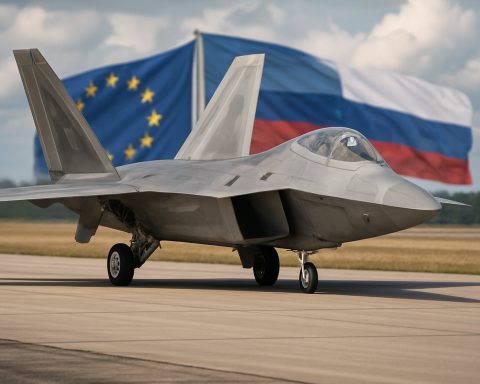- Palantir Technologies has experienced a substantial 279% stock surge in the past year, driven by excitement around generative AI and political factors.
- The company’s integration of Large Language Models (LLMs) has enhanced its reputation in AI applications, especially in defense and public health.
- Political dynamics, notably Donald Trump’s 2024 election and co-founder Peter Thiel’s political ties, have bolstered investor confidence.
- Palantir faces potential challenges due to U.S. policy shifts, like a reduced Pentagon budget, which could affect its government revenue stream.
- The company’s stock valuation, with a high price-to-earnings ratio of 156, suggests potential overvaluation amid operational and revenue growth concerns.
- Investors should approach Palantir’s prospects with caution, keeping an eye on evolving political and economic conditions.
In the dense forest of Wall Street, where volatility is king and fortune can turn on a dime, Palantir Technologies has emerged as a beacon of speculation and intrigue. Once a shadowy player in the realm of big-data analytics, it now stands in the glaring lights of financial analysts and investors, thanks to a breathtaking 279% surge over the past year.
Born amidst the tumult of an IPO in 2020, Palantir carved a niche providing data-driven insights, from thwarting terror plots to orchestrating public health responses. Yet, its recent stratospheric rise finds roots in less tangible soil. Headlines about generative AI—the latest tech darling—coupled with political winds blowing across the United States, have fueled its rally. As AI captured imaginations worldwide, Palantir deftly integrated Large Language Models (LLMs) into its suite, promising battlefield efficacy and beyond.
Politically, the landscape provided an unexpected tailwind. The 2024 election of Donald Trump, and the proximity of co-founder Peter Thiel to power corridors, bolstered investor confidence. Thiel’s connections to influential figures like Vice President JD Vance added a tantalizing extra layer of political allure. However, this complex quilt of influences raises questions about the sustainability of Palantir’s prosperous moment.
The corporate spotlight isn’t all flattering. The same administration that buoyed Palantir could clip its wings. As Trump’s regime pushes for peace in Ukraine—an area where Palantir has been instrumental—its market potential could diminish. Moreover, Defense Secretary Pete Hegseth’s intent to slash the Pentagon’s budget marks another looming cloud. Such policy shifts threaten to muffle Palantir’s dominant position in the governmental sector, where it garners most of its revenue.
On the business front, while Palantir’s revenues have risen, they haven’t mirrored the explosive growth of industry peers like Nvidia. Their operational results, while decent, paint a more muted picture than the AI-powered narrative suggests. Beyond this, the company grapples with an unsettling dependency on stock-based compensation, which siphons potential shareholder gains.
Despite a formidable price-to-earnings ratio of 156—a figure that towers over more grounded valuations—Palantir’s stock doesn’t yet factor in these multifaceted obstacles. Its identity hinges precariously between being a data company with AI flair and a strategic entity reliant on government coffers. News of defense cuts or diminishing AI fervor could deflate this hot-air balloon, making current valuations appear overly optimistic.
For investors enchanted by AI’s siren song, the takeaway is clear: seek value beyond glamour. While Palantir offers a feast for the zeitgeist, astute analysts should ponder its feast or famine prospects. As the clocks tick toward 2025, the challenges ahead demand scrutiny and caution, lest one mistake temporary euphoria for lasting legacy.
Is Palantir’s Meteoric Rise in Stock Value Sustainable?
Understanding Palantir’s Exponential Growth
Palantir Technologies has been at the forefront of attention with a spectacular 279% increase in stock value over the past year. This growth, attributed to strategic maneuvering in the tech and political arenas, offers fascinating insights and prompts questions about its sustainability.
The Generative AI Buzz
Palantir’s integration of Large Language Models (LLMs) into its platforms is a driving force behind its stock surge. These AI advancements position Palantir as a tech pioneer capable of offering high-value, data-driven solutions applicable across industries—from national defense to healthcare.
– Use Cases of LLMs: Palantir’s AI initiatives extend beyond traditional data analytics, providing robust solutions for prediction modeling, operational efficiencies, and even real-time decision making in complex environments.
– AI and Market Dynamics: The buzz around AI can often inflate company valuations, as seen in Palantir’s case. However, the market trends suggest a maturation phase where only those with innovative, applicable solutions will continue to thrive.
Political Influence and Risks
The political landscape has significantly impacted Palantir’s fortune. Co-founder Peter Thiel’s proximity to influential political figures, alongside a favorable administration, has boosted investor confidence.
– Real-World Implications: Given the close ties to political figures, policy changes—like proposed Pentagon budget cuts or peace negotiations in Ukraine—could affect Palantir’s government contracts and revenue streams.
– Future Speculations: Geopolitical shifts or a change in administration policies against defense spending could result in diminished government contracts for Palantir, pressing the need for diversification.
Financial Analysis and Market Position
Palantir’s current financial health indicates a gap between soaring stock prices and fundamental business metrics.
– Stock-Based Compensation: Palantir relies heavily on stock-based compensation, which, while aligning employee interests with stock performance, poses the risk of diluting shareholder value.
– Comparison with Peers: Compared to tech titans like Nvidia, Palantir’s revenue growth remains comparatively stagnant despite its soaring stock price.
– Price-to-Earnings Ratio: A towering P/E ratio of 156 raises eyebrows, underscoring potential overvaluation concerns.
Challenges and Limitations
While Palantir’s story resonates with the AI zeitgeist, multiple challenges loom that could impact future performance.
– Dependency on Government Contracts: Heavy reliance on government contracts makes Palantir vulnerable to policy and budgetary fluctuations.
– Diverse Applications Needed: To ensure longevity, further diversification into private sectors and enhanced AI applications beyond defense and intelligence could be crucial.
Actionable Tips for Investors
1. Diversification: Look at companies with sustainable diverse revenue streams beyond government contracts.
2. In-Depth Research: Scrutinize future financial reports and policy changes that may affect defense contracts.
3. Monitor AI Developments: Stay informed on AI industry trends and technological advancements within Palantir’s offerings.
Conclusion
Investors enchanted by Palantir’s recent stock performance should approach with pragmatic caution. While the AI and political allure is strong, tangible growth and diversification beyond current niches are crucial for future resilience. As the market continues to evolve, thorough analysis and a balanced portfolio will be key to making informed investment decisions.
For further financial analyses and insights on AI industry developments, visit Palantir Technologies.







